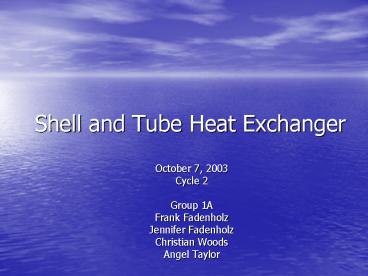Shell and Tube Heat Exchanger - PowerPoint PPT Presentation
1 / 27
Title:
Shell and Tube Heat Exchanger
Description:
Shell and Tube Heat Exchanger October 7 ... and Tube Shell and Tube Heat Exchanger Background Shell and Tube Heat Exchangers Account for 60% of heat exchangers ... – PowerPoint PPT presentation
Number of Views:2867
Avg rating:3.0/5.0
Title: Shell and Tube Heat Exchanger
1
Shell and Tube Heat Exchanger
- October 7, 2003
- Cycle 2
- Group 1A
- Frank Fadenholz
- Jennifer Fadenholz
- Christian Woods
- Angel Taylor
2
Outline
- Objectives
- Background
- Experimental Strategy
- Results
- Error Analysis
- Conclusions
- Recommendations
- References
3
Objectives and Background
4
Objectives
- Operate shell and tube heat exchanger varying
steam flow - Determine the outside overall heat transfer
coefficient (Uo) - Determine shellside heat transfer (QSS)
- Determine tubeside heat transfer (QTS)
5
Heat Exchanger Background
- Exchange heat between fluids
- Latent heat and sensible heat transfer
- Common to chemical process industry
- Types of heat exchangers
- Air Cooled
- Double Pipe
- Spiral Plate and Tube
- Shell and Tube
6
Heat Exchanger Background
- Shell and Tube Heat Exchangers
- Account for 60 of heat exchangers in use today
- Can handle large flows, low temperatures and
pressures, high temperatures and pressures - Our shell and tube heat exchanger
- Basco Type 500 U-tube Water Heater
- 1 Shell Pass
- 16 Tubes
7
Experimental Strategy
8
Should make Labels Larger
9
Experimental Strategy
- 5 Runs Total
- Varied Steam Valve (TV-04) Position
- 105 open
- 75 open
- 65 open
- 60 open
- 52 open
- Cooling water flow rate constant
10
Experimental Strategy
- Measured Variables
- Condensate flow
- Condensate temperature
- Cooling water flow
- Cooling water inlet temperature
- Cooling water outlet temperature
11
Heat Exchanger Calculations
- Heat transfer rate
- QTS mCpDT
- QSS mDH mCpDT
- Overall heat transfer coefficient
- Uo QSS/(AoDTLM)
- Log mean temperature
- DTLM ((Thi-Tco) (Tho Tci)) / ln(Thi
Tco) (Tho Tci)
12
Simplified Process Flow Diagram
Thi
Qin, SS
Tci
Qout, TS
Qin, TS
Tco
Qout, SS
Tho
13
Results
14
Experimental Results
Steam Valve Open Heat Transfer Rate (QTS)(btu/hr) Heat Transfer Rate (QSS)(btu/hr) Overall Heat Transfer Coefficient (Uo)(btu/lbFhr)
105 276489 275350 211
75 250275 254588 201
65 183357 181872 148
60 134200 133777 112
52 98289 93757 78
15
Shellside vs. Tubeside Heat Transfer
16
Steam vs. Heat Transfer Rate (QTS, QSS)
17
Steam vs. Overall Heat Transfer Coefficient
18
Error Analysis
19
Propagation of Error
- Determine the accuracy of measured variables
- Apply the propagation of error equation to each
function
20
Variable Measurement Accuracy
- Flow rate of the steam /- 5 lb/hr
- Flow rate of the cooling water /- 50 lb/hr
- Temperature readings /- 2 F
- Largest sources of error
- Mass flow rate of the steam
- Mass flow rate of the cooling water
21
Calculated Error Values
- ?QTS /- 1,000 btu/hr
- ?QSS /- 50,000 btu/hr
- ?Uo /- 4 btu/lb F hr
- ?Ui /- 4 to /- 1.6 btu/lb F hr
22
Propagation of Error Heat Transfer
23
Propagation of Error Heat Transfer Coefficient
24
Conclusions and Recommendations
25
Conclusions
- QTS, QSS, Uo all increase as the steam flow rate
increases - QTS, QSS, Uo all have a linear relationship with
the mass flow rate of the steam - Heat transfer rate of the tube side is equal to
the heat transfer rate of the shell side
26
Recommendations
- Operation Recommendation
- Operate the shell and tube heat exchanger at
approximately 75 for sufficient heat transfer
and economic efficiency - Experiment Recommendations
- Monitor pressure gauge (PG-07) at low steam rates
to prevent a vacuum
27
References
- API Heat Transfer. Shell and Tube Heat
Exchanger Picture - www.apiheattransfer.com/en/Products/HeatExchanger
s/ShellAndTube/ - Georgia Tech. Propagation of Error.
www.swiki.che.gatech.edu/CHE4200. August 2002. - Geankoplis, Christie J. Transport Processes and
Unit Operations, 3rd ed. Englewood Cliffs, NJ.
Prentice-Hall Publishing, Inc. 1993. - Heald, C. C. Cameron Hydraulic Data. Liberty
Corner, NJ. Ingersoll-Dresser Pump Co. 1998. - Peters, Timmerhaus, West. Plant Design and
Economics for Chemical Engineers, 5th ed. New
York, NY. McGaw-Hill Co. Inc., 2003.
28
(No Transcript)































